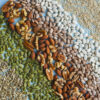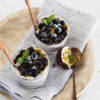
If you’re a kid, milk is all the rage. My kid’s school cafeteria is littered with “Got Milk” posters and if you ask them what helps build strong bones, they will tell you “ugh, we know it’s dark, leafy vegetables even though all our friends say milk.” Milk is the ultimate kid super food but I made a decision when my oldest turned one, to give her almond milk instead of regular milk. My pediatrician thought I was a nut job but I honestly felt like cow’s milk made her super mucous-y and constipated. Throughout the years, I kept having more kids and kept giving them almond milk once they turned one. They all loved it and did super well on it. Four kids and exactly none of them have ever had an ear infection or suffered from constipation—those facts alone made me convinced it was my anti-milk stance. (Also, I know writing that last sentence was just the kiss of death so I promise to let you all know about the raging ear infection/constipation plague that is about to hit our house). Also, I want to add in here, that they do have cow’s milk sometimes at school and while at friend’s house-it’s just that in our house is almond milk. But, even though they have loved almond milk, I know that it’s not any sort of super food. It doesn’t have much protein, and unless you are making your own (I tried to once and my kids literally spit it out on the floor), it’s loaded with additives, which I don’t like. As they have gotten older, they really only have maybe a cup a day, but for my one year old, he needs a lot more of it. It’s always been an internal struggle, but I’ve never settled on anything else. Fast forward to this spring when I was reading an article about foods that help combat seasonal allergies. Side note, I totally love stuff like this for a couple of reasons: 1) I obviously believe food can cure any ailment, and 2) my youngest son suffered some pretty bad eczema as a baby and there’s a strong link between allergies of any type and eczema so I try to stay well-informed of any findings. One of the items on the list was “raw milk” which made me think and think and think.
Let me stop here and give some background of what raw milk is. First off, you’re not going to find it in the grocery store—it’s actually illegal to sell raw milk in Massachusetts anywhere other than the farm on which it was produced. The milk you see in the grocery store has all been pasteurized meaning that after the milk was taken from the cow, it was heated up to 160 degrees for 15 seconds. Benefits of pasteurization are that it kills off potentially harmful bacteria and provides a 2-3 week shelf life for milk as opposed to raw milk which sours quickly. Some milk is “ultra-pasteurized” which means that it’s heated at 280 degrees and can have a shelf life that extends up to nine months. In addition to killing off some bacteria, a lot of valuable vitamins and minerals are destroyed in the pasteurization process. Raw milk enthusiasts say that the benefits of not heating milk to such high temperatures will keep the beneficial bacteria in tact, as well as minerals (hi calcium and strong bones!), vitamins A, B, C, D, omega 3 fatty acids, amino acids and enzymes. Interesting to note that pasteurization kills off a good amount of the mineral iodine, which without it can lead to constipation. Equally interesting is that one of the enzymes killed off in the pasteurization process is lactase, which is what’s necessary to digest milk. Lactaid and other lactose-free milks are just regular milk with the enzyme “lactase” added back in. In fact, many people who have always considered themselves “lactose intolerant” are able to digest raw milk without issue.
So what is the issue? Well, the big one is that it’s a raw food and the CDC and USDA aren’t big fans of raw foods as they can lead to some serious illnesses and death (rightly so, from their perspective). This is obviously a huge concern, but fear not, because you can get food-borne illnesses from almost every food out there (hello hummus, hello spinach, hello potato salad). Also, for big food companies, it’s always in their best interest to have foods be shelf-stable for longer periods of time (a la high fructose corn syrup and trans fats) which is another appealing aspect of pasteurization.
OK, enough about the “why nots” of raw milk, let’s “why” a little, shall we? So, what’s is the link between asthma, seasonal allergies and raw milk? The thinking is that raw milk contains proteins and other compounds that can keep the immune system content as well as the notion that by leaving things unpasteurized, the good bacteria stay put keeping the biodiversity of our gut happy.
Being the ever-experimenter that I am, I decided to see what the hype was about (I think the last time I had a glass of raw milk was on our 5th grade trip to a farm). I looked up some reputable “dealers” on realmilk.com and settled on one of the membership ones that delivers to my door (Miller’s Biodiversity Farm). I had been mentally prepping my big kids the day before it came about how it may taste a little different than the milk they were used to at school, but keep an open mind, this milk has more vitamins and minerals and actually can help make your bones strong, blah blah blah. I only got a half gallon to play it safe, but this is what my half gallon looked like an hour later:
Scarfed it! So much so, that I ordered more right away, but this time a gallon. My oldest said it tasted like “plain, melted, ice cream” and my one year old banged his bottle against the fridge when he was out (aka the universal toddler symbol for “more”).
In all honesty, raw milk is an issue that I know is really controversial for a lot of people. And unlike my egg tirade, I don’t want to persuade people or discourage people from buying the type of milk they like. I totally understand why someone wouldn’t buy raw milk and I don’t fault them. I just think it’s so interesting that some of the issues that can come from milk may also be cured by milk, just a different type. Are we going to have raw milk in the house forever? Who knows, but it’s always fun to try something new. Because this is a nutrition blog, I will offer my opinion, don’t worry (ha!). Regardless of the type of milk you buy, from a nutrition standpoint, I feel that one should always buy whole milk and that it should be organic. In terms of raw milk, I love that I am supporting a family farm and giving my kids a nutritionally dense product at the same time. I want my kids to be educated about where their food comes from, (I’ll write a post sometime about the time I took my sensitive child to the meat farm) but I also want them to be able to look with an objective eye at some of the food messages out there. So, the next time my kids are asked what food gives them strong bones, I want them to be able to confidently say “milk!” and to know why it can be. Then they can mutter under their breath all they want about those darn leafy greens that mom always makes them say.











